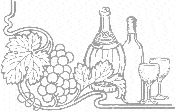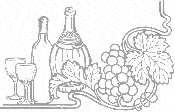Fermentation, Wine, Beer and Spirits in Cooking

I do not consume alcohol as a matter both of personal choice and religion. This essay will sound like a justification of my consumption of products containing alcohol, but if you think a little harder about it, you’ll realize that it is an explanation of the many ways in which we consume the products and by-products of fermentation every day.
Those who eshew alcoholic beverages for the damage they inflict upon society and the slavery they create are nevertheless beholden to the industry that produces them for products that probably do not come to their minds.
Indeed, it’s the abuse or inability to moderate their use that makes them so dangerous to humans.
Wine and vinegar
When very young, I questioned the use of wine in sauces and thought it strange to go to the trouble to do that. Convinced I was missing something, I experimented using grape juice instead. It took only one, carbonized, nasty, sugary mess to clean up and I understood why sauces could not be made with unfermented grape juice.
It’s the sugar, of course. The chemistry of fermentation causes the sugars in fruit like grapes to be transformed into alcohol. This sugar gone into a more benign form, the wine can be used to temper the flavors of sauces. The alcohol mostly evaporates away and the effect is subtle, but obviously pleasant.
So, whether you consume wine in sauces or not, you surely have on many occasions consumed it on a salad. Let me explain.
The English word for wine comes from Germanic, Wein in German. In French, this word is similarly related, though spelled vin and comes from Latin uinum. Another word in English, acrid, is related to the French word, aigre, which means bitter, sour or acidic. When you put these two words together as the French do, you have vinaigre, in English, vinegar.
Vinegar is simply wine that, whether by mistake or by design, went through an ærobic fermentation sometime during its creation. There isn’t anything mystical about this: if you let any oxygen into the fermentation of sugar, you’re going to end up with flavors you’re probably not looking for—sour or bitter ones.
It’s completely natural. When vinegar was offered to Jesus on the cross, the soldiers weren’t going so much out of their way to insult Him, it’s just that they were’t going to take their best amphore of Château Judea 33 and leave it hanging around at work.* What they had was wine that had gone bad—probably because it was left open to the air.
(* I mean no inappropriate levity here, but only use this to illustrate what I believe to be a modern misconception.)
Wine in those days was consumed for reasons including that potable water was hard to obtain. As soon as grapes could be pressed into new wine, wine that hardly had the time to ferment properly into what we would call wine today, it was being drunk by all. As it sat around, unsealed, for weeks, it turned into vinegar and people drank it with diminishing relish until it was just used for something else. (I don’t know what, cleaning supplies? I mean, the ancients weren’t stupid.)
So, the French, during the Middle Ages if not before, are drinking wine that tastes doubtful and ask themselves, “What can we do with this? It’s really no longer good to drink.” The answer was to mix it with oil, herbs and aromates like garlic or onion, and make a vinaigrette out of it to put on salad. Capital idea! And, it sops up nicely with bread improving its flavor too!
Beer and Bread
In earliest times, man learned to make bread and beer. Beer is just liquid bread. Today, it gets flavored with hops and over the ages many things have been done to alter its appeal, but fundamentatlly, beer is liquid bread and has ever been part of man’s diet. Over bread, except for its enclosure and transportation, it had the advantage of being impervious to most types of contamination precisely because of its alcoholic content. Sort of like the utility of storing water in the form of wine: it was a safe bet even if it left you impaired if you drank too much of it.
Note that children drank beer too. A second draining during the sparing process in beer-making produced a lighter-bodied, less alcoholic beer that sold for less as well.
In modern times, beer’s utility as a primary food source is no longer so important. We can preserve bread and get nutrients from so many other sources that the beverage has been relegated to recreational drink. (And that is in fact one of its problems, but a rant for another day and in a different setting.)
Yeast is part of the natural process of fermenting beer and wine. Yeasts are present directly on the harvested grapes. They can be introduced on purpose or willy nilly to wheat or other grains fermenting in water. It’s a short trip from the natural to the manufactured process and bakers’ yeast is a by-product of the fermentation industry. That’s right, your package of Red Star or Fleishmann’s comes from a brewery somewhere.
Because almost no one bakes bread from sourdough starts anymore, all the bread we eat is risen thanks to the fermentation industry.
Spirits
Last, we get to spirits by which I mean distilled alcohols used in flavoring desserts and other dishes. When extracted flavors are bottled for use in baking, like vanilla, berries, etc., frequently alcohol plays an important part of the process of extraction and is often the very excipient of the extract. Only, long before consuming enough of it to become inebriated, it would make you sick like those grocery store cooking wines so full of salt that they would make you heave long before your head began to spin.
Alcohol evaporates at temperatures far below water. Thus, as you bake your cake or heat a syrup, any alcohol that was added as part of the flavoring goes away. Sure, not all of it goes away, but how much is left in the vinegar you eat? Very little in either case.

The point is—and this is where you’ll accuse me of justifying myself—you consume products or by-products of fermentation in myriad forms every day without succumbing to alcoholism. If you cannot leave a bottle of wine or liquor alone sitting in your cabinet, then give up making anything that requires it. If, like me, you aren’t tempted, you’re only doing in your home to your own prepared food what a processing plant is doing to the food in that package you used to eat out of.
Additional Notes
Pliny the Elder, a well known writer and historian of the Latin classical period, wrote that Gauls and Iberians use the foam skimmed from fermenting beer to “produce a lighter kind of bread than that of other peoples” in his acquaintance. Elsewhere in the ancient world, among cultures that drank wine rather than beer, a paste composed of grape juice and flour was allowed to begin fermenting as a source for yeast.
The most common species of yeast used in bread-baking and ale-making (top-fermenting) is saccharomyces cerevisiae, named using Greek and Latin words for sugar, fungus (mushrooms) and beer. In the Latin word for beer, cereuisia, (cervesa in Spanish), you see the word that gives us cereal and the name of the goddess of grain and abundance, Ceres.
Lager, distinct from ale, is made using a bottom-fermenting yeast, often, saccharomyces pastorianus (“country” or “field” sugar fungus).
(Word etymologies are a hobby of mine: I went to the University of Paris to study Greek, Latin, French and Linguistics.)
People understood that beer was safe to drink whereas their water supply often was not. Ironically, it never occurred to them to think that the reason their beer was safe to drink was that the process of making beer included boiling the water which killed all the bacteria and that, therefore, if they had boiled their water, it would have been safe too. Without the alcohol, at least, for a while. We commonly referred to pirates consuming rum on shipboard; this is because after a barrel of water has been at sea for a while, it’s full of worms and other unspeakable filth.
Old-style root beer production by yeast fermentation is stopped short of alcohol production leaving sugar and only trace amounts of alcohol. It is done for carbonation only. Some beer carbonation is accomplished the same way (by continued fermentation in the final storage container) when it is not done by carbon dioxide injection.
Yeast in wine production is already present on the surface of the grapes (the white film), however, in real production, various strains of saccharomyces cerevisiae are used instead to produce more predictable results.
In contrast to beer, wine was safe not because it was boiled, but because the moisture (water) in it was only that coming from the grape in the first place.